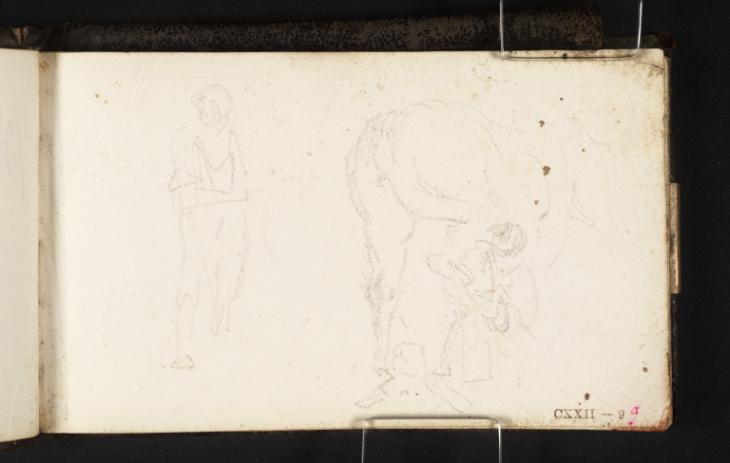Joseph Mallord William Turner Study for 'A Country Blacksmith': Shoeing a Horse c.1807
Image 1 of 2
Joseph Mallord William Turner,
Study for 'A Country Blacksmith': Shoeing a Horse
c.1807
Joseph Mallord William Turner 1775–1851
Folio 9 Recto:
Study for ‘A Country Blacksmith’: Shoeing a Horse c.1807
D08297
Turner Bequest CXXII 9
Turner Bequest CXXII 9
Pencil on white wove paper, 69 x 112 mm
Inscribed by John Ruskin in red ink ‘9’ bottom right
Stamped in black ‘CXXII – 9’ bottom right
Inscribed by John Ruskin in red ink ‘9’ bottom right
Stamped in black ‘CXXII – 9’ bottom right
Accepted by the nation as part of the Turner Bequest 1856
References
1909
A.J. Finberg, A Complete Inventory of the Drawings of the Turner Bequest, London 1909, vol.I, p.339, CXXII 9, as ‘Blacksmith shoeing horse’.
1981
William Chubb, ‘Minerva Medica and The Tall Tree’, Turner Studies, vol.1, No.2, Winter 1981, p.34, pl.14, as ‘A Smith shoeing a horse’.
1984
Martin Butlin and Evelyn Joll, The Paintings of J.M.W. Turner, revised ed., New Haven and London 1984, p.53 under no.68.
2001
Martin Butlin, ‘Country Blacksmith Disputing upon the Price of Iron, and the Price Charged to the Butcher for Shoeing his Poney’ in Evelyn Joll, Martin Butlin and Luke Herrmann (eds.), The Oxford Companion to J.M.W. Turner, Oxford 2001, p.65.
Although the poses of the figures and the horse observed here do not correlate exactly with those in Turner’s A Country Blacksmith Disputing upon the Price of Iron, and the Price Charged to the Butcher for Shoeing his Poney, exhibited at the Royal Academy in 1807 (Tate N00478),1 this page, the studies on folio 8 recto and verso (D08295, D08296) and the forge interiors on folios 4 recto and 5 recto (D08288, D08290) do appear to have informed the painting. The figure with folded arms here is comparable with the one shown on the opposite page (D08296). Martin Butlin and Evelyn Joll have observed that the horse is shown ‘being shod, in the same pose but involving the other leg’2 in a slightly less inelegant pose in the finished composition. An ink drawing of busy interior in the Hesperides (1) sketchbook (Tate D05801; Turner Bequest XCIII 22a) is possibly related to the painting, albeit with many differences.
William Chubb related the present study to the 1807 painting in the course of his reasoning for the dating of inscriptions later in this sketchbook (see folios 40 recto, 41 recto, 42 recto; D08346, D08348, D08350).3 Butlin and Joll noted a suggestion to the latter by the artist Derek Chittock (1922–1986) that ‘there was a blacksmith’s forge just by W.F. Well’s [sic] cottage at Knockholt, on which this picture [i.e. A Country Blacksmith] may have been based.’4 Turner often visited his artist friend William Frederick Wells (1762–1836) at Knockholt, Kent, including the occasion in October 1806 traditionally noted as the point of origin for Turner’s Liber Studiorum print series (see the present author’s Introduction to the ‘Liber Studiorum c.1806–24 section of this catalogue). Whether an adjoining forge can be linked with the sketches here or the subsequent painting is a moot point. The identifiable subjects in this book are along the River Thames (see the Introduction).
Verso:
Blank
Matthew Imms
September 2013
How to cite
Matthew Imms, ‘Study for ‘A Country Blacksmith’: Shoeing a Horse c.1807 by Joseph Mallord William Turner’, catalogue entry, September 2013, in David Blayney Brown (ed.), J.M.W. Turner: Sketchbooks, Drawings and Watercolours, Tate Research Publication, September 2014, https://www


